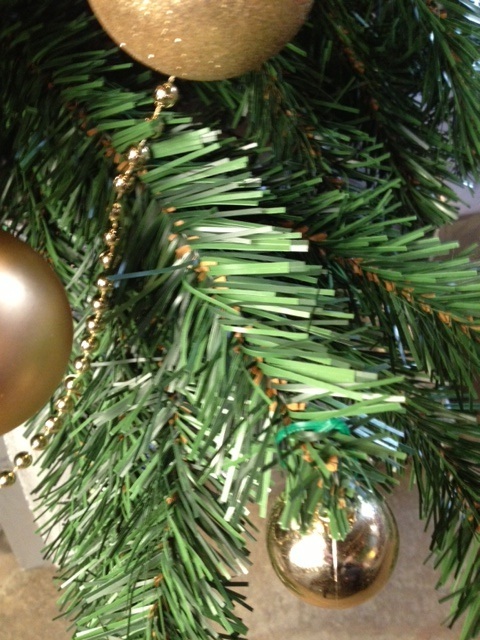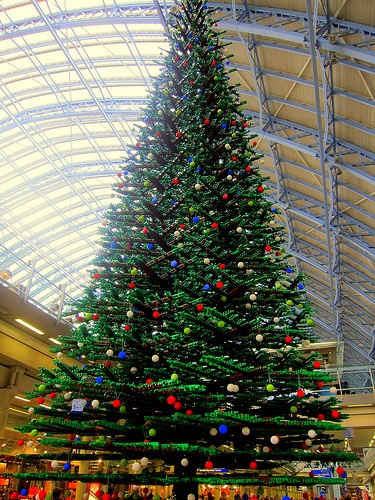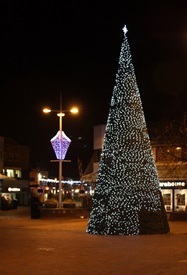It's that time of year when you rummage around in the loft for the decorations and stand in line for a nicely shaped Christmas tree. You can't beat the smell of a real pine, but if you can't face wrestling to get it in and out of the car, why not fake it?
Today's artificial trees offer a convincing alternative with a minimum of fuss. They also have other advantages such as eliminating allergies, insects and piles of pine needles on the floor. While artificial trees are not totally maintenance free, the commitment to them is much less than their real life counterparts. Aside from trees that try to replicate a real tree, more abstract trees are also now commonplace.
Early artificial trees
Traditionally, the Christmas tree is an evergreen conifer such as a pine or fir. As with the specification of live plants and trees, it may be possible to ensure the provision of a required aesthetic for an artificial tree by specifying botanical names. However, it is worth noting that manufacturer's use of the same botanical names as natural trees will quite often refer only to the species. Artificial trees were introduced in the 18th century in response to deforestation in Germany, where the modern natural Christmas tree is credited to have originated. They were made of green dyed goose feathers attached to wire branches and wrapped around a central dowel acting as a supporting trunk. Decorations were edible goodies such as apples, nuts or dates, and illumination was provided by candles.
You can't beat the smell of a real pine, but if you can't face wrestling to get it in and out of the car, why not fake it?
 Materials
Materials
Due to vast improvements in manufacturing technology, artificial trees are becoming more realistic and botanically correct. Polyester silk fabric is used for foliage and screen-printed with details such as leaf veins to give a lifelike appearance. However, polyester silk is often manufactured from low temperature plastics which tend to burn easily and give off toxic combustion products, so fire retardant treatment is essential. Natural wood with embedded preserved natural leaf is most realistic for stems.
Some artificial trees are suitable for exterior locations, particularly sheltered external areas such as balconies. Perhaps the most popular materials are weather resistant PVC plastics which give a more realistic appearance than cheaper aluminium tin foil foliage. PVCs are not normally suitable for interior use as they will not accept any form of flame retardant treatment. A polymer material with a UV inhibitor has been developed to prevent the product from fading or changing colour over a period of time. However, the use of water-resistant and fade-resistant materials may limit the choice of designs available.
 In recent years, less conventional materials have been used to replicate the Christmas tree including lego.
In recent years, less conventional materials have been used to replicate the Christmas tree including lego.
Fire
Artificial trees must be treated with a fire retardant when located in internal public areas and escape routes. While artificial trees have traditionally been associated with high fire risk, with the specification of fire retardant pre-treatments and post-installation spray coatings, this risk can be mitigated. In some manufacturing processes, fire resistance can be incorporated by adding a retardant chemical into the materials before the tree is assembled. Where available, this is recommended to prevent the need for maintenance and re-application of treatments. Alternatively, spray coatings can be applied, which are generally cheaper; however, they have a number of disadvantages such as a limited life of 6 to 12 months (depending on cleaning frequency) before re-application is necessary. Applied intumescent lacquers produce good results but are usually built up of two base layers and a gloss or matt finishing coat, which tends to leave treated foliage looking thicker and more artificial.
No British Standard specifically covers the flammability of artificial trees. However, BS 9999, Code of practice for fire safety in the design, management and use of buildings, section D.3.6 'Furnishings, fabrics and decorative features', indicates that such features should be 'non-combustible' or conform to BS 5867-2 (a Standard for drapes and curtains) 'type B' which refers to ignition resistance.
Portability
The artificial tree offers the advantage of being portable. Branches are now snapped or clicked into place or simply fold away. For visual appearance, they offer the advantages of instant impact and a mature look.
When specifying large artificial trees, it is worth considering the trunk material. For a realistic look, a 'natural', seasoned or preserved wood can be used with embedded leaf, as noted above. For ease of transportation, a lightweight, hollow injection moulded or GRP material should be considered.
It is also worth bearing in mind that when large trees are being transported or offloaded there must be adequate clearance to overhead power lines. BS 4043 recommends that the power line operator should be consulted if a minimum clearance of 15 m (lines between steel towers) or 9 m (lines between timber poles) cannot be maintained. Also consider the tree's location, for example, if situated within a shopping centre, it may obstruct CCTV camera sight lines. Other security and health and safety issues may require a barrier around the base of the tree. A recent artificial tree installed at a shopping outlet centre in Cheshire measures 27.5 metres, 10 m wide and required planning permission.
Base
While small trees may only require a moderate portable base, larger tees may require in-situ support in the ground or containers. Embedding in concrete or clay of sufficient depth for the weight and height of the tree may be necessary. The top surface can then be disguised with lightweight expanded clay aggregate (leca), decorative gravel or similar or even Christmas presents!
Summary

To keep trees looking their best, leaves and should be free of dust, branches adjusted to mimic a natural form, and broken or missing parts replaced. It is important to specify a tree that is suitable for the environment in which it will be located. Keep up with trends such as pre-lit, frosted, coloured, fibre optic and upside down trees.
While artificial trees have many benefits in that they can be reused each year, unlike real trees they cannot currently be recycled due to the combination of materials that are used to make it. Artificial trees are not to everyone's liking. In 2009, a large artificial tree was assembled in Poole, Dorset. With no branches or decorations, a simple design without weighty decorations was erected due to the fear of it blowing over with the high coastal winds, receiving criticism for resembling a cone.
Whether you decide on a real tree or 'fake it' don't forget the tinsel, ribbon, traditional tree topper and decorations and make sure such that they are from non-combustible materials. Sit back, relax and enjoy, before its time to take it all down again. And get ready to do it all again next year!
Inline image 1: Close up
Inline image 2: Lego Tree, St Pancras (Image: Bex Walton)
Inline image 3: Poole, Dorset (Image: Tanya Hart)


